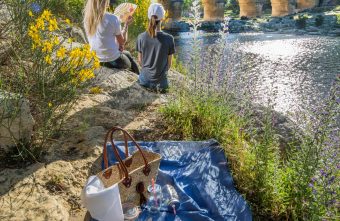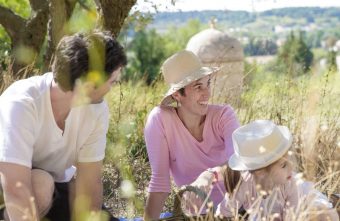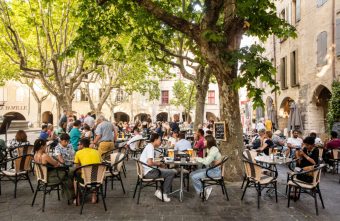There are so many heritage sites in the Pays d’Uzès Pont du Gard destination. History buffs will be spoilt for choice! Our towns and villages are charming and have some surprises up their sleeves.
Exploring the small heritage sites
You’ll pass by these historic traces of everyday life every single day. They are a key part of our identity. Crosses, wells, statues, wash-houses, fountains, belfries, oratories, etc. They all bear witness to our history. It would be a shame to walk past them unknowingly, as they have so much to tell you about the life of the men and women who have lived here over the years. Why not discover them in a fun way or on a guided tour?
The art of dry-stone construction
Maybe you’ve already heard, but the art of dry-stone construction has been added to the list of Masterpieces of the Oral and Intangible Heritage of Humanity! And while you’re staying at the Pays d’Uzès Pont du Gard destination, at the heart of the scrubland, you are sure to catch a glimpse of dry-stone walls and “capitelles” (dry-stone shelters).
Of these many objects, one of them is characteristic of our region, the “capitelles”. A “capitelle” is a dry-stone shelter. They were used as temporary shelters for people, tools or farming products. They can mainly be seen in the French department of the Gard, where they originated. If you would like to find out more, there are regular walking tours and themed tours based on these constructions.
Explore our towns & villages
Aramon
Half way between Avignon and Beaucaire, the village of Aramon is set out like an amphitheatre at the foot of its Château. You’ll be astounded by the excellent condition of the heritage sites in this village.
Aramon is at the confluence of the Rhône and Gardon rivers, and is heavily marked by the presence of water. The port here flourished in the 17th century and as such, a great number of private manors were built in the town, namely Forton, Jossaud, Posquières, Laudun, Saint-Jean and Choisity.
While exploring Aramon, don’t miss:
- The hiking trails: Capitelles, Levadon, Garrigue and Castillones (leaflets are available from the Tourist Office);
- Walk along the ancient waterfront of the Rhône;
- Explore the Ilot d’Alfred nature and leisure area, “La Lône”;
- The weekly market on Wednesday mornings;
- The old town centre: the church of Saint-Pancrace (12th – 17th century) and the 1st-century Roman gravestones both inside and outside the church;
- the traditional Saint Martin celebrations of the 11th November and the Saint Jean celebrations on the 23rd June.
The Culture and Heritage Office (OCPA) organises guided tours: +33 (0)4 66 62 97 28.
Castillon-du-Gard
This village, perched up on its oppidum, keeps a watchful eye over the majestic Pont du Gard.
In this medieval village, typical of the Gard Provence, you can discover parts of the ancient fortifications on the west side. Castillon-du-Gard went from being a Protestant town to a Catholic one, and back again several times, before being dismantled between 1626 and 1628. In the middle of the 19th century, in light of the growing population, a second church was built, combining Roman and Gothic styles.
While exploring Castillon-du-Gard, don’t miss:
- The pretty medieval streets of the village, with ochre-coloured houses;
- The view of Gardon Valley, the vineyards and the Pont du Gard;
- The medieval chapels of Saint-Christophe and Saint-Caprais;
- The ruins of the Puits Neuf and Articoyse leprosariums;
- The market on Tuesday mornings, between July and September;
- The votive celebrations in July.
Collias
In this town at the heart of the Gorges du Gardon, you’ll find everything you need for a relaxing holiday: swimming, visits, lazing about, sports activities, etc.
Collias is on the left banks of the Gardon, and its name is of Greek origin. The occupants have left their mark over the centuries: occupation of Palaeolithic caves, Roman, then Pagan, then Palaeochristian traces at the classified Ermitage site. The largely untouched landscapes of the Gorges du Gardon and the vast plateaus overlooking them are ideal for hiking, and there is a wide range of activities available on the river. Collias was a hotspot for silk production until the 19th century. It is also the birthplace of the “picholine” olive.
While exploring Collias, don’t miss:
- The classified Ermitage site;
- the chapel of Notre Dame de Laval and the 19th-century church of Saint-Vincent and the paintings inside;
- The many climbing and via ferrata trails;
- Canoeing and kayaking;
- The GR 63 hiking trail;
- The Gorges du Gardon: natural site protected for its wildlife.
Take a tour of the village with the Association les Amis du Patrimoine, call +33 (0)4 66 22 80 87.
La Bastide d’Engras
La Bastide is a former fortified communal farm. In the north-east of the village, overlooking Tave valley, Saint-Jean d’Orgerolles chapel stands proudly. On a clear day, there is a remarkable view of Mont Bouquet in the distance.
This bastide is one of the most ancient in France. In the village, research has revealed the presence of Man as early as Prehistoric times. The seigneury was occupied by the counts of Toulouse until 1209, and then became part of the bishopric of Uzès.
In light of the many clashes during the War of the Camisards in the 18th century, the inhabitants of the village requested that the ramparts be rebuilt. Their wish was granted and the people from nearby villages also came here to seek refuge. In the north of La Bastide d’Engras, the 11th-century Saint-Jean d’Orgerolles chapel overlooks the valley from a hilltop.
While exploring La Bastide d’Engras, don’t miss:
- The Château de la Bastide d’Engras;
- La Tave river;
- The clock tower and wrought iron steeple;
- The 15th-century Saint-Jean d’Orgerolles chapel;
- The church and two paintings (17th-century) listed as historic monuments;
- The Monastère de Solan.
La Capelle-et-Masmolène
La Capelle-et-Masmolène is classified a “Site Pittoresque”(scenic spot) and is in fact two hamlets, combined into one single town in the 19th century. Ancient remains of shelters and Prehistoric pottery bear witness to the presence of the Fontbouisse civilisation in the Neolithic era.
The village owes its existence to the Benedictine monks in the Middle Ages.
La Capelle’s 11th-century feudal caste was the summer residence for the Bishops of Uzès until the Revolution. The nearby Château de Masmolène, at an altitude of 800 metres, has a remarkable 11th-century Roman chapel. The pond was drained by the monks in the Middle Ages and is today a classified “Natura 2000” site.
While exploring La Capelle-et-Masmolène, don’t miss:
- The Etang de La Capelle;
- The Rochers de La Capelle climbing spot;
- The 12th-century Feudal castle;
- The 19th-century early Romanesque churches;
- The ruins of the keep and the Romanesque chapel of Saint-Pierre de Masmolène;
- The windmill.
Pougnadoresse
The village is on a rocky headland overlooking Tave valley, with a wide range of picturesque walks to choose from, across vineyards, past fruit trees and through the scrubland, with a magnificent view of Mont Ventoux and the Alps.
In some of the very early writings, the château appears under the name Castrum de Pugnixduritia. Known as the Fortress of the Rock, the name Pougnadoresse undoubtedly comes from the rocks on which the village was built, “pena” meaning rock and “duro” meaning fortress.
In 1156, the seigneury and its outbuildings was given by the young King Louis to the bishop of Uzès. The château was made up of a main tower from the Carolingian period, and a double fortified enclosure from the 12th century, including an impressive round tower that was once used as an ice house.
In 1562, Honoré Le Chantre, the King’s advisor and “co-seigneur”, the former name for today’s “owners”, became the only lord of Pougnadoresse.
The château did not escape the various wars and revolutions through the ages. It was however saved from a fire in 1790 thanks to the quick-thinking locals.
The same family has resided in the château for 450 years.
While exploring Pougnadoresse, don’t miss:
- The 10th-century château;
- The church with two bell towers;
- The communal oven and indoor wash-houses, some of the village’s small heritage sites.
Remoulins
Remoulins is 5km from the Pont du Gard, half way between Avignon and Nîmes and its name is derived from the Provençal word “remoulin” which means whirlwind.
Life in this village is mainly concentrated along the main road, but just a few metres away, you can explore the medieval part of the village and some remains from the Middle Ages, including the Romanesque church of Notre Dame de Bethléem, the 2 medieval towers, the keep and the 12th-century fortified gates.
From the car park you can also walk along the embankment which protects the historic centre from the rising waters of the Gardon, then walk along the banks of the river until you reach the dam, before heading into Vieux Remoulins.
Much of the town was destroyed during the religious wars between the Protestants and the Catholics in the 16th and 17th centuries. There are still some remarkable remains of medieval heritage here. And the houses, some of which have been beautifully restored, feature mullioned windows, ogees over the doors and windows, etc.
Of the ramparts surrounding the village, protecting it from flooding, only the 12th-century fortified gate remains, including a drawbridge, the 11th-century Tour de Escaravats with some remains of machicolations.
While exploring Remoulins, don’t miss:
- The ancient church of Notre-Dame-de-Bethléem
- The ancient suspension bridge (Seguin bridge – piers and “octrois” (toll stations))
- Saint-Martin de Ferlières chapel
- The church of Saint-Martin-Notre-Dame (parish church)
- The Château de Rabasse
- The many cherry trees
Saint-Siffret
Saint-Siffret is a medieval village built on the side of a limestone cliff. It was occupied by Man from as early as Prehistoric times, the Neolithic era with troglodyte dwellings dug into the foot of the cliff. Saint-Siffret was transformed in the Middle Ages when two châteaus were built, overlooking the valley.
One of them which still has its square-shaped tower and small fortified entrance was a commandery of the Knight Templars, built in the 12th century. The other one is the Château de Saint-Siffret, an ancient Protestant upper-class residence.
While exploring Saint-Siffret, don’t miss:
- The trail along the headland and the orientation tables;
- The 12th-century Roman-Byzantine style church;
- Two châteaus, one of which is a former commandery of the Knight Templars;
- The 19th-century clock tower and wrought iron steeple.
Vallabrix
Vallabrix, also mentioned under the name Volobrica, takes its name from the Gallic tribe of Volo.
From Prehistoric times onwards, people came to settle in Brugas, on the south side of the village.
According to a Carolingian registry, Vallabrix, the church, outbuildings and domains were handed over to the church of Saint-Théodorit in Uzès in the 9th century. In the 12th century, the château belonged to the count of Toulouse, Raymond VI, who acquired it from the bishop of Uzès.
The first known lord of Vallabrix, honoured by King Francis the First, was Mathieu de Bargeton in 1533. From the 17th century, the château became a “co-seigneurie” with the Bargeton family and other nobles. in the 19th century, it was divided into two plots of land, a house and a barn, it is no longer a noble residence.
Today, we can still see the magnificent Renaissance façade of the château which has recently been restored.
While exploring Vallabrix, don’t miss:
- Two “Balade des Arbres Remarquables” discovery trails to see around thirty species of trees (booklet available from the town hall or the Pays d’Uzès Pont du Gard destination tourist office);
- The 11th-century Romanesque church, extended in the 19th century;
- The Renaissance-style façade in the medieval fort;
- Condamine fountain and the wash-house;
- The 19th century Clos d’Ozon cross.
Vers-Pont-du-Gard
You are now at the heart of a village that was behind the construction of the Pont du Gard: follow in the footsteps of the Romans along the “Sentier de la Pierre” trail!
In the medieval village, there’s a small monastery and a few farmhouses built around the church, surrounded by walls and square-shaped towers, of which only the clock tower remains today. When the Knight Templars disappeared, the Château de Saint-Privat (7th century) was sold as a Royal estate, to a private buyer. There are three water sources here, flowing from the limestone rock, to supply the fountains and wash-houses, including the indoor wash-house known as the “Grand Font”.
While exploring Vers-Pont-du-Gard, don’t miss:
- The 3 wash-houses;
- Saint-Pierre chapel;
- The Vers stone quarries, used in Roman times to build the Pont du Gard for example;
- The Prehistoric caves (Balauzière, Salpétrière);
- The church (wall paintings, statutory charter, paintings);
- The clock tower;
- The Pont du Gard and other remains of the Roman aqueduct;
- Hiking trails including the “Itinéraire Aqueduc”, the “PR, Petite Randonnée”, the “Chemin des Calvaires”;
- The trail to discover Vers stone: “sentier d’interprétation de la pierre”.
 Ticketing
Ticketing  Pass
Pass
 Gift box
Gift box  Groups & business
Groups & business 
















